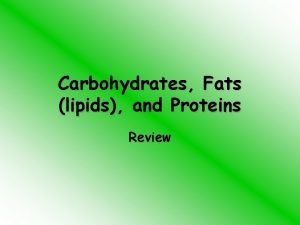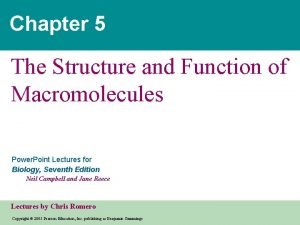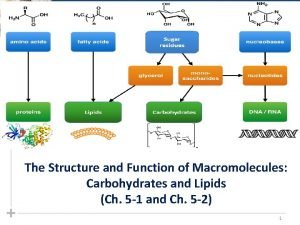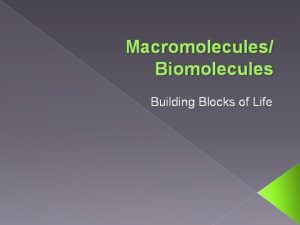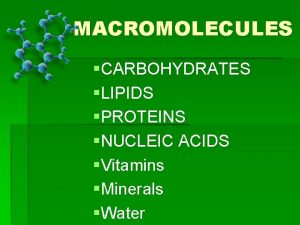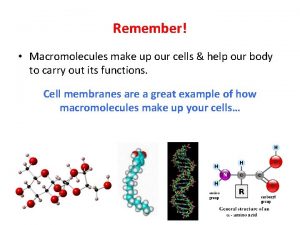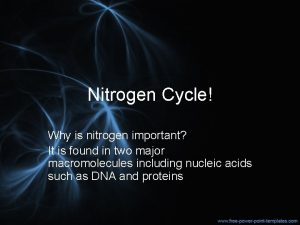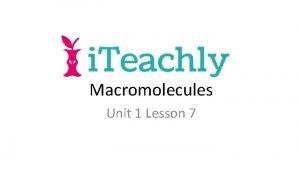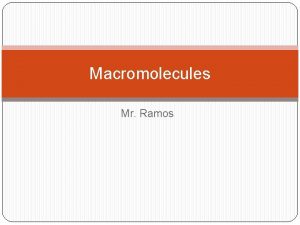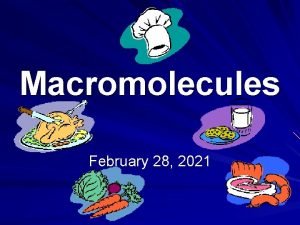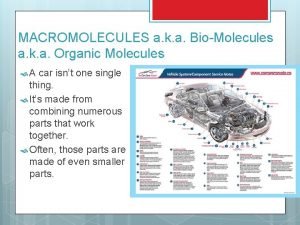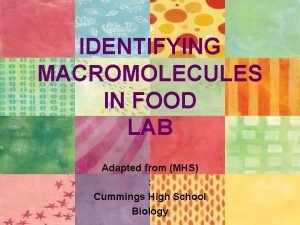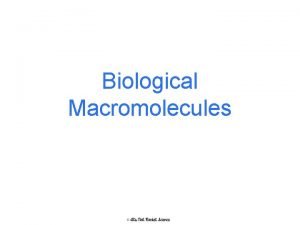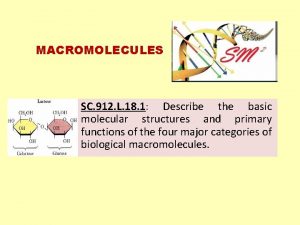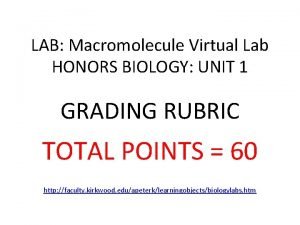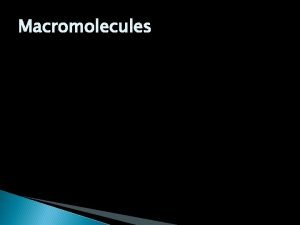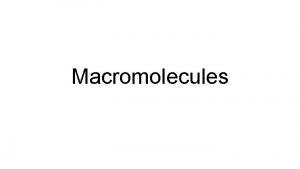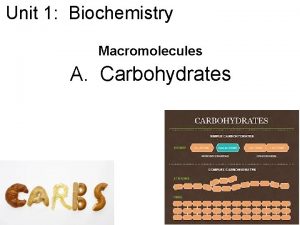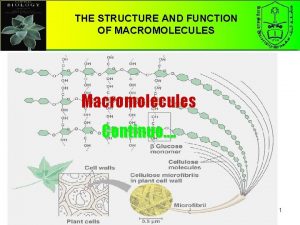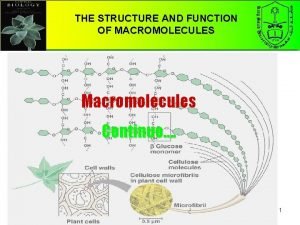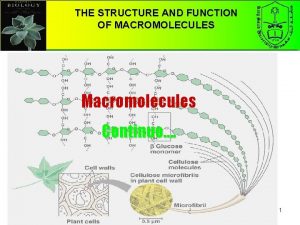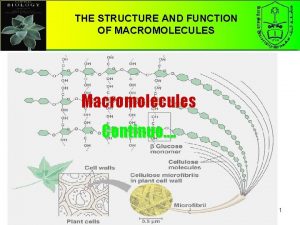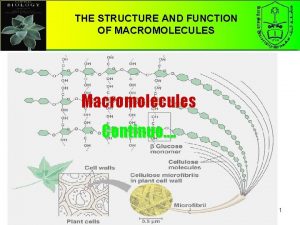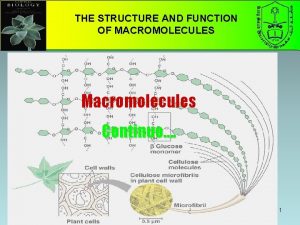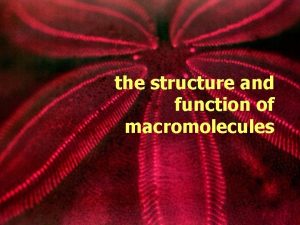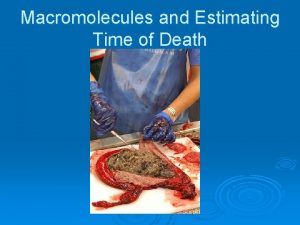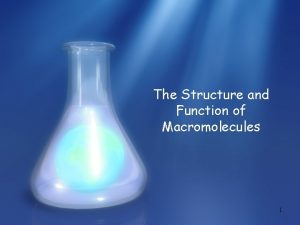8 11 Solutions of macromolecules 1 Macromolecules and
















- Slides: 16

§ 8. 11 Solutions of macromolecules

1. Macromolecules and their solutions Macromolecules: a chain-like molecule with its molar mass higher than 10000. Natural macromolecules: protein, starch, cellulose; Artificial macromolecules: PE, PP, PS, nylon-66 Lyophilic sol – solution of macromolecule (1) Spontaneous dissolution/dispersion; (2) thermodynamically stable; (3) Weak Tyndall effect; (4) High viscosity.

2. Osmotic pressure of macromolecular solutions Virial factor At low molality indissolvable Can be used to determine molar mass of macromolecule

3. Donnan Effect of macromolecular solutions polyelectrolyte Na. P H 2 O c Semipermeable membrane It’s hard to determine molar mass of a polyelectrolyte.

Na. P Na. Cl c b Two limiting cases: b<<c b>>c When a very large amount of Na. Cl is present, the Donna effect can be completely eliminated. The other way to eliminate Donna effect?

4. Viscosity of macromolecular solutions Newtonian viscosity law: Relative viscosity Specific viscosity Reduced viscosity Intrinsic viscosity c is concentration in g/ml

Relationship between intrinsic viscosity and molar mass of macromolecule For spheric molecule: = 0 For rod-like molecule: = 2 For flexible thread-like molecule: = 0. 5~1. 0 In good solvent: > 0. 5; in bad solvent: 0. 5

5. Salting-out of macromolecule Salting In Addition of salt at low ionic strength can increase solubility of a protein by neutralizing charges on the surface of the protein, reducing the ordered water around the protein and increasing entropy of the system. Salting out (Can be used for Fractionation) If the concentration of neutral salts is at a high level (>0. 1 mol/L), in many instances the protein precipitates. This phenomenon apparently results because the excess ions (not bound to the protein) compete with proteins for the solvent. The decrease in solvation and neturalization of the repulsive forces allows the proteins to aggregate and precipitate.

Salting-out effect: Used to selectively precipitate proteins, often with (NH 4)2 SO 4 which is cheap, effective, does not disturb structure and is very soluble.

5. Gelation of macromolecule solution Gel: Jelly like material formed by coagulation of a colloidal liquid. Many gels have a fibrous matrix and interstices filled with fluid: gels are viscoelastic rather than simply viscous and can resist some mechanical stress without deformation. Silica gel: Na 2 Si. O 3 + HCl water content > 95 % Soybean curd:

Structure of gels Si. O 2 V 2 O 5 gelatin rubber Gels are formed by the interlocking of the dispersed particles in the form of a loose framework inside which liquid or gas dispersion medium is contained.

Bicontinuous phase Sponge, a solid-gas dispersion system with all the solid phase and gas phase connecting.

Classification of gels On state of phases: 1) s-l gel: human body, curd, jelly 2) s-g gel: silica gel, sponge On mechanical properties: 1) elastic gels: molecules are held by electrostatic forces 2) rigid gels: silica gel with a network of chemical bonds. 3) thixotropic gels: kieselguhr/water

thixotropic gels:


the progress of colloid chemistry Prehistorical application : clay, Chinese ink, soybean curd. Recent 1663, Cassius: Au sol; 1809, Pencc: electrophoresis; 1827, Brown: Brownian movement; 1857, Tyndall: Tyndall effect 1861, Graham, colloid chemistry; 1903, Zsigmondy: Ultramicroscopy; 1907, Banmap. H, nature of colloids Ostwald: dispersed system 1923, T. Svedberg, Ultracentrifuge; 1930 s, Staudingur, macromolecules 1941 -1948, Derjaguin-Landao-Vervey-Overbeek: DLVO theory.
 Micromolecules and macromolecules
Micromolecules and macromolecules What macromolecules are in bread olive oil and pasta
What macromolecules are in bread olive oil and pasta Chapter 5 the structure and function of macromolecules
Chapter 5 the structure and function of macromolecules Macromolecules and their monomers
Macromolecules and their monomers Macromolecules building blocks
Macromolecules building blocks Site:slidetodoc.com
Site:slidetodoc.com Macromolecules in steak
Macromolecules in steak Ciclo del fosforo
Ciclo del fosforo Macromolecules
Macromolecules What are macromolecules
What are macromolecules Nucleic acid examples food
Nucleic acid examples food Macromolecule chart
Macromolecule chart Subunits of fat
Subunits of fat Sudan iv test
Sudan iv test What are macromolecules
What are macromolecules Monosacharride
Monosacharride @vividorange2
@vividorange2

